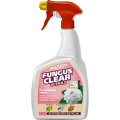

Box blight
What is box blight?
Box blight, or Boxwood blight, is a common fungal disease that can destroy box plants. At first it causes brown, bare patches on the plant, which spread as the plant dies back and eventually dies. It is particularly devastating to see neatly clipped box plants overtaken and ruined by this now widespread fungus.
There are two fungi which cause box blight. Calonectria pseudonaviculata and Calonectria henricotiae (also called Cylindrocladium buxicola) are the culprits. They thrive in warm, wet and humid conditions. The fungi will affect leaves and stems, but not the roots, so recovery is possible with tenacity and a little luck.
Any plant in the Buxaceae family can host and be attacked by the fungi. This includes the much loved winter-flowering Sarcococca confusa, as well the common Japanese spurge (Pachysandra terminalis). However it is plants in the Buxus genus, which includes the popular Buxus sempervirens - or common box - which are particularly vulnerable.
What does box blight look like?
You need to catch box blight early on for the best chance of managing it effectively. The fungus is active all year round, but especially in wet conditions, when you are most likely to find visible fungal growth on an infected plant.
Other pests and diseases can cause similar symptoms to box blight, so check for the those before starting any treatment. Volutella blight is often confused with box blight as it has most of the same symptoms, except that it has pink fungal growth instead of white. Box tree caterpillars also cause widespread browning and loss of leaves, and are usually accompanied by webbing across the foliage. Neither of these problems cause dark streaking on the stems however, and this can be another way to differentiate them from box blight.
You should monitor box plants closely for signs of pests and diseases, regularly checking them and taking action no matter what the problem is.

Box blight symptoms and damage
What does box blight look like? Look out for:
- Brown leaves
- Leaves falling from the plant
- Bare patches of foliage, particularly on the tops of plants
- Dark streaky marks on stems
- White-grey fungal growth on the undersides of leaves
- Dying and dead plants
Box blight treatment
So, how to treat box blight? You should take action as soon as you see any symptoms of box blight. It will swiftly take over a plant and may spread to nearby plants in the Buxaceae family. It can quickly become difficult to control and it is unlikely to disappear of its own accord.
There are no known biological treatments for box blight. Chemical controls are largely ineffective as all above ground parts of the plant need to be coated. Box grows very densely, so reaching every surface is difficult. A fungicide spray such as FungusClear® Ultra 2 can be useful when pruning, to prevent the spread of spores.
For badly infected plants, wait for a dry day to dig them up and destroy them immediately. For smaller infections, you can try to prune out the affected sections. Just make sure to cut back further than where the infection is visible to catch any unseen infected material. If box has been used to provide a low hedge, use a hedgecutter to prune horizontally across the entire length. Box blight spreads from the top down, and this will keep it looking relatively tidy, with a hope that the infection hasn’t spread further down into the plant.
All prunings from an infected plant should be destroyed and not composted. Move them by placing them in a sealed container first, so that material does not fall to the ground as you cross the garden. You should then remove fallen foliage and topsoil from beneath the plants to minimise the chances of box blight spores surviving.
How to prevent box blight
Box disease can arrive seemingly out of nowhere, with spores spread by the weather and wildlife. It’s not possible to stop this happening, but you can help plants to resist and recover from attacks from all sorts of pests and diseases by keeping them healthy. To do so, feed regularly with a granular fertiliser, such as Miracle-Gro® Premium All Purpose Continuous Release Plant Food or Levington® Growmore Multi Purpose Plant Food.
There are some other actions you can take to reduce the chance of box blight arriving in your garden. Practice good garden hygiene by securely disposing of infected material, and cleaning tools and clothing between use. Use a fungicide if attempting to prune out infected material.
Avoid planting box plants in damp, shady areas of the garden, and make sure that other plants do not prevent good air circulation.
Newly purchased plants should be quarantined away from others for a month or more. Check them thoroughly and frequently for symptoms. Isolating plants gives the fungus a chance to emerge in a controlled environment before it has a chance to spread. If you notice symptoms, destroy the infected plants immediately.
Avoid planting anything related to Buxus close to an area where there was previously an outbreak of box blight. The minute fungal spores can live on infected material for up to 6 years. You could try planting something which is not in the Buxaceae family. There are lots of good alternatives for attractive topiary designs and hedging, such as Privet and Yew (Taxus baccata).












